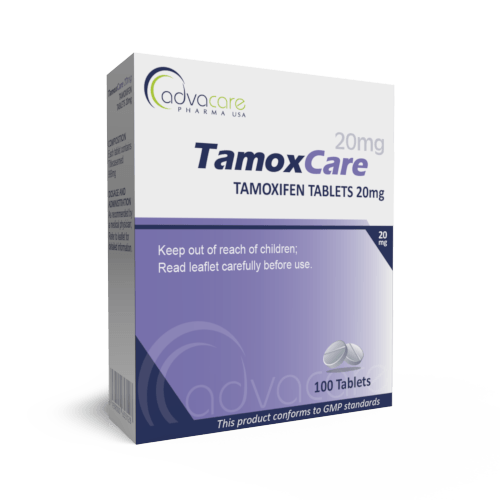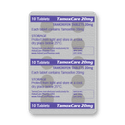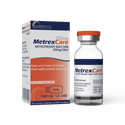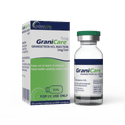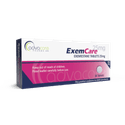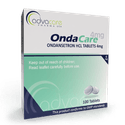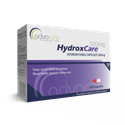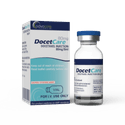- Home›
- Pharmaceuticals›
- Oncology Products›
- Oncology Tablets›
- Tamoxifen Tablets
Tamoxifen Tablets
Dosage
Packaging
What is Tamoxifen?
Active Ingredients: Tamoxifen
Tamoxifen Tablets are an antineoplastic drug used to treat hormone-positive breast cancer that has spread to other parts of the body, in both women and men. It can be used to lower the risk of developing breast cancer for women with high risk, for example, with a family history of breast cancer.
The active ingredient, Tamoxifen, is a selective estrogen receptor modulator. It works by blocking the actions of estrogen in breast cells, which therefore stops the growth of estrogen-dependent cancer cells.
Tamoxifen Tablets are produced with a dosage of 10mg, 20mg, or 40mg. This product is available packaged in a box containing 100 tablets.
AdvaCare Pharma is a global distributor and manufacturer of Tamoxifen Tablets. We offer a wide range of high-quality and cost-effective oncology medications that are available for distribution. Our medications are produced in our GMP-certified facilities in China, India, and the USA.
Why are we a trusted Tamoxifen manufacturer?
AdvaCare Pharma manufactures Tamoxifen Tablets, one of 40+ oncology treatments, according to rigorous GMP protocols at our state-of-the-art production facility. We are committed to producing quality-assured, cost-effective cancer treatments that meet the highest industry standards and are readily available to cancer patients worldwide. As an established Tamoxifen manufacturer, we supply pharmaceutical distributors, hospitals and government institutions with reliable cancer drugs.
Uses
What is Tamoxifen used for?
It is used to treat certain types of breast cancer in both women and men. Tamoxifen is also used to prevent breast cancer in women with high risk.
How should Tamoxifen Tablets be used?
These tablets have been manufactured to be taken orally. This medication may be taken with or without food.
How should Tamoxifen Tablets be stored?
The tablets should be kept in their original packaging until use. They should be stored at room temperature in a location that is dry, dark, and cool. Do not put this medicine in a freezer or refrigerator.
Do not use this medicine if it is past its expiry date. Refer to any local guidelines on how to properly discard outdated medications.
What dose of Tamoxifen should be taken?
Adult Dosing Recommended dosage guidelines may vary depending on medical condition:
- As adjuvant treatment for hormone-receptive breast cancer, the usual dose is 20mg. Tamoxifen should be taken for 5-10 years after a total or partial mastectomy, axillary dissection, or breast radiotherapy.
- For the treatment of metastatic hormone-receptive breast cancer in either women or men, the usual dose is 20-40mg divided, given once or twice per day. If the dose is greater than 20mg per day, it should be divided and given twice per day.
- For early ductal cancer that has not spread, the usual dose is 20mg taken once per day. Treatment should continue for 5 years after breast surgery and XRT.
- For the prevention of breast cancer in high-risk women, the usual dose is 20mg taken daily. The duration for treatment should be 5 years.
- For mastaglia, the usual dose is 10mg taken once per day. The duration of treatment should last for 4 months.
- For ovulation induction, the usual dose is 5-40mg, taken twice per day. The duration of therapy should last 4 days.
Renal Dosing No adjustment is recommended for patients with renal impairment.
Hepatic Dosing Guidelines are not defined for patients with hepatic impairment.
Pediatric Dosing For precocious puberty due to McCune-Albright syndrome in females ages 2-10 years old, dosage determination should be individualized by healthcare providers, accounting for factors such as age, weight, and medical history.
Renal Dosing for pediatrics Guidelines are not defined for children with renal impairment. It is advised to consider the recommendations for dosing adjustments for adults.
Hepatic Dosing for pediatrics Guidelines are not defined for children with hepatic impairment.
Refer to a doctor or pharmacist for guidelines on dosage. Do not exceed what they advise. The exact dosage will depend on the therapy and symptoms.
What happens if a dose is missed?
The forgotten dose should be taken as soon as possible. If it is nearly time for the next dose, the missed dose should be skipped. Never take more than 1 dose at a time.
Who can use Tamoxifen?
Tamoxifen Tablets can be given to adults and children, but caution is advised for specific groups of patients.
Pregnant The use of tamoxifen should be avoided during pregnancy. Based on limited human data and the drug’s mechanism of action, there is a potential risk of fetal harm, such as teratogenicity and fetal death.
Before beginning treatment, it is recommended to perform a pregnancy test within 7 days of beginning treatment for any patients who are still in their reproductive years. These individuals should be advised to use effective non-hormonal forms of birth control for the duration of their treatment and at least 2 months after stopping therapy.
Breastfeeding It is recommended to avoid breastfeeding while undergoing treatment with tamoxifen and for 3 months after the last dose. There is no human data available to assess possible risks of infant harm. Based on human data, this drug has been associated with decreased milk production, particularly during early postpartum.
Children This drug is not recommended for pediatric patients younger than 18 years old, as safety and efficacy guidelines have not been established. In limited studies in adolescents, this drug was considered safe and well tolerated with little difference in pharmacological efficacy.
Geriatric The elderly population has a higher incidence of breast cancer as they age. Specific guidelines for this population have not been properly studied, despite it being the leading cause of death for cancer patients over 60 years old. When determining a treatment plan for this population, it is important to consider the increased risk of impaired organ function and treatment-related toxicity along with any existing health issues and current medications.
Other warnings
This medication has a black box warning as there are uterine malignancies and thromboembolic events, associated with the use of this drug. Fatal cases have occurred in regard to both types of complications. It is advised to discuss the risks versus the benefits of this treatment in high-risk patients.
For patients with a history of thromboembolic events (such as deep vein thrombosis and pulmonary embolism), the benefits must be weighed against the risks before beginning treatment with tamoxifen. This medicine is associated with an increased incidence of thromboembolic events.
For patients with hereditary angioedema, it should be noted that this drug may cause or worsen symptoms of this condition.
For patients with a risk of developing blood clots, this drug should be used cautiously.
For patients with preexisting hyperlipidemias, it is recommended to monitor cholesterol and triglyceride levels, as this medicine has been associated with Hypercholesterolemia and hypertriglyceridemia.
There have been reports of hypercalcemia, with the appearance of bone metastases within a few weeks of treatment. Hypercalcemia should be treated as appropriate; however, it is recommended to discontinue therapy in the event of severe hypercalcemia.
It is advised to conduct regular CBD (Complete Blood Count) and liver function tests during treatment with tamoxifen and for a period of 9 months following discontinuation of therapy.
Side Effects
As with all pharmaceuticals, some unwanted effects can occur from the use of Tamoxifen Tablets.
Some common side effects include, but are not limited to:
- vaginal bleeding or discharge
- hot flashes
- swelling
- weight gain
- nausea
- mood changes
Seek medical attention if the following side effects develop:
- painful swelling in a leg
- breathlessness, sudden chest pain, or difficulty breathing
- swelling of the face, mouth, or throat
- severe skin reactions
- abnormal vaginal bleeding or discharge
- pelvic pain or pressure
- feeling bloated
- a new breast lump
- cysts
- fibrosis
- polyps or thickening of the womb lining and cancer of the womb
- eye problems, including changes to the cornea or retina and cataracts, or pain in the eye
- changes with vision, blurred vision, or seeing halos around lights
For a comprehensive list of all possible effects, consult a doctor.
If any symptoms persist or worsen, or you notice any other symptom, then please call your doctor immediately.
Precautions
Do NOT use Tamoxifen Tablets if:
- You are allergic or hypersensitive to tamoxifen or any of the excipients in the tablet.
- You are currently taking warfarin.
- You have undiagnosed vaginal bleeding.
- You are pregnant.
Consult with your doctor about any medications, supplements, and herbal products you are taking before your treatment. Certain medications may need to be changed or their dosages adjusted. Some medicines that may need additional considerations include oral contraceptives, hormone replacement therapy, antidepressants (paroxetine, fluoxetine, bupropion), quinidine, cinacalcet, and rifampicin. There are serious interactions that may occur between tamoxifen and drugs such as anastrozole or letrozole. This is not a complete list.
Some types of health conditions may require dosage adjustments or additional monitoring. Inform your doctor of any history of health conditions, including:
- a history of strokes or blood clots
- liver disease
- high cholesterol or triglycerides
- eye problems such as cataracts
- history of chemotherapy
- pregnancy or breastfeeding
The use of tamoxifen during pregnancy or breastfeeding is not recommended. Consult a doctor or healthcare professional before taking tamoxifen.
Driving or operating machinery should be avoided, as the medication may cause eye problems.
This drug may affect the results of certain laboratory tests. It is important to inform medical staff that you are undergoing therapy with tamoxifen.
During treatment with this drug, it is important to regularly self-examine the breasts for lumps, and have regular physical exams and mammograms.
Tamoxifen is associated with a possible increased risk of uterine cancer, liver cancer, stroke, or a blood clot in the lung.
Premenopausal women may experience less frequent periods while undergoing therapy with tamoxifen.
Tamoxifen 20mg: Why the most common dose?
Tamoxifen 20mg is the standard dose for treating and preventing breast cancer, balancing efficacy and side effects. It reduces cancer recurrence risk while minimizing health impact. Lower doses, like Tamoxifen 10mg, are used for specific cases based on patient tolerance and response.
References
The role of tamoxifen in the treatment and prevention of breast cancer
This is a nonsteroidal antiestrogen that has found successful applications for each stage of breast cancer. It is also used as a palliative treatment of premenopausal women with estrogen receptor (ER) positive disease.
It can be used as an adjuvant therapy for women with node-positive breast cancer. Laboratory studies show that long-term treatment schedules may provide maximal benefit in preventing recurrence, and recent treatment between 2 and 5 years of adjuvant tamoxifen therapy provides a survival advantage for postmenopausal women with node-positive disease.
There are no reports about the teratogenicity of tamoxifen in humans.
This research shows that tamoxifen is a safe drug and there are only a few reports of endometrial carcinoma being diagnosed during adjuvant therapy with tamoxifen.

You might be interested in...
Why AdvaCare Pharma?
As an industry leader, we are aware of our responsibility to provide affordable and sustainable solutions to improve healthcare worldwide.
